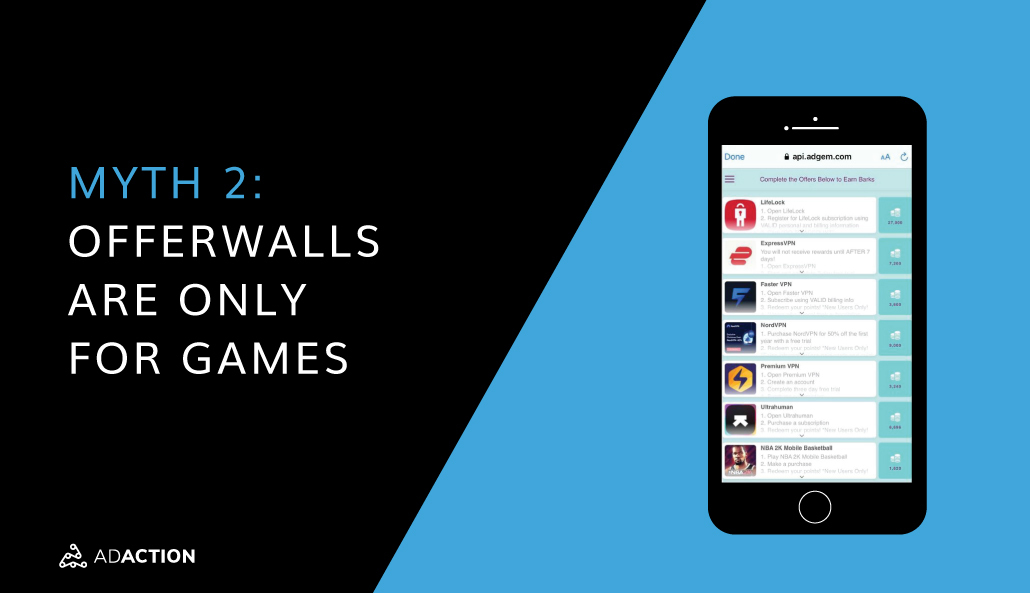Offerwalls are very attractive to mobile app marketers and developers. They drive monetization and user acquisition (UA) without even looking like an ad. This growing interest, however, is often met with some uncertainty. There are misconceptions about this ad unit, and we want to bring clarity by setting straight some common offerwall myths.
Let’s dive in and debunk.
Myth 1: Offerwalls Negatively Impact IAPs
In-app purchases (IAP) fuel revenue. IAPs can range from subscriptions to individual purchases for in-game currency. Do mobile offerwalls keep users from IAPs? No, not at all. They work together to build engagement and loyalty.
Completing activities on the offerwall ads does reward users, but they don’t remove the need for IAPs. Those that interact with them are loyal users looking to gain incentives by completing events. They are investing their time, not their money. In a way, it’s two different audiences.
Data also points to this fallacy. In fact, players that engage with offerwalls 10 to 14 times more likely to make an IAP transaction down the road. Those same individuals also have higher ARPPU (average revenue per paying user).
Based on our own internal assessment, we can also agree that offerwall engagement can lead to more IAPs.
Myth 2: Offerwalls Are Only for Mobile Games


Gaming is the top category for this inventory. It started within this segment, but relegating its application to one app type is another misconception. They can support any free-to-play app using microtransactions to structure gameplay. More recently, other app types like entertainment, shopping, news, and social networks. It can be an opportunity for engagement across all engagement levels. The key is to incentivize an action and get a reward.
For example, a shopping app could use one to prompt creating an account or adding a payment method. The reward could be a discount. A media app could leverage one to offer premium content if the user registers.
Thinking too inside the game box is a myth. There are many more opportunities for using them.
Myth 3: Offerwalls Don’t Improve Monetization
Monetization, solely focused on in-app advertising and IAPs, has been a standard tenet. Many haven’t branched out from these strategies. Marketers who find the most monetization success realize the value of offerwalls. They deliver a new incremental revenue stream in a user-initiated way. By employing offerwall best practices, you can boost monetization.
In our experiences, apps that add offerwalls to their monetization strategy can dramatically grow their ARPDAU (average revenue per daily active user). You can scale this approach and hit unique user groups. It becomes a tool for UA as well as continued deep engagement with loyal audiences.
Myth 4: Offerwalls Don’t Support Retention
This myth is the easiest one to debunk. After all, offerwalls are some of the most engaging ad units because they don’t disrupt. Users choose to interact with them. It’s not a typical ad that gets annoying.
Offerwalls keep users on apps longer. In the traditional setting of gameplay, they can offer in-game currency, which the player needs to keep going. In non-games, you can use it for deep engagement at specific events that you know align with retention.
Experts have studied this myth, finding that offerwall users, when compared to non-users, stay longer.
Myth 5: You Can Only Use CPE Models
CPE (cost per engagement) models are the most popular for offerwalls, but not the only ones. Some offerwalls do have limitations around the types of campaigns. This isn’t exactly inaccurate, as it depends on who your provider is. If that’s a concern for you, then you’ll appreciate that our offerwall allows for CPI (cost per install), CPA (cost per action), and CPC (cost per click) campaigns across Android, iOS, mobile web, and desktop.
The Truth Is Out
Now that we’ve broken down the myths, you can move forward without any misinformation. If you’re considering your offerwall opportunities, be sure to download our infographic, 8 Reasons to Tap AdAction As Your Offerwall Provider


